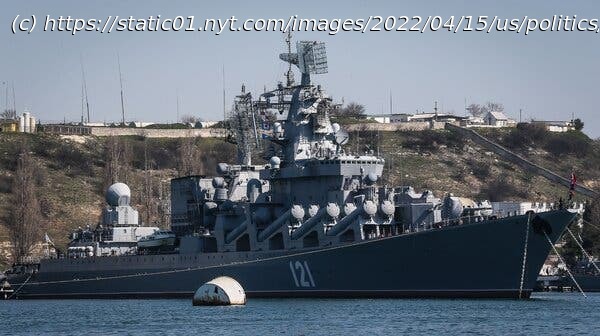The sinking of the Moskva was a major blow to the Russian fleet and the most significant combat loss for any navy in decades.
The Moskva was the pride of Russia’s Black Sea Fleet, a symbol of the country’s dominance of the region and a powerful war machine that had been used to launch precision cruise missiles deep inside Ukraine. Despite claims by Russia that an accidental fire broke out on the ship, U.S. officials confirmed on Friday that two Ukrainian Neptune missiles had struck the vessel, killing an unknown number of sailors and sending it and its arsenal to the bottom of the Black Sea. The sinking of the Moskva on Thursday was a grave blow to the Russian fleet and a dramatic demonstration of the current era of warfare in which missiles fired from shore can destroy even the biggest, most powerful ships. It was also the most significant combat loss for any navy since 1982, when Argentina’s Air Force sank a British guided missile destroyer and other ships during the Falklands War. The Russian cruise missiles have been used to brutal effect on apartment buildings in Ukrainian cities, and the Moskva’s guns had fired on Ukraine’s Snake Island. The Kremlin’s most powerful missile platform is impossible to replace, and its sinking was a bold counterattack, retired military officers said. The Moskva inspired awe in those who saw it — bristling with missiles and looming over the landscape — and was the embodiment of Russian power in the region for decades. “It was a very impressive ship,” said retired Rear Adm. Samuel J. Cox, the director of the Naval History and Heritage Command in Washington. “With those surface-to-surface missile launchers, she really looks dangerous. But apparently, she can’t take a punch.” The vessel’s sinking has symbolic, diplomatic and military importance. Russian ships have already been pushed farther off the Ukrainian coast, U.S. officials confirmed, speaking on the condition of anonymity to discuss intelligence assessments of the war. The remainder of Russia’s Black Sea Fleet is still within range to launch cruise missiles into Ukraine but is unable to support any sort of amphibious assault on the country’s coastal cities, according to former officials. Naval analysts have worried for years that a new generation of ship-killing missiles would endanger large and important ships like the Moskva or the United States’ fleet of aircraft carriers. The sinking of the Moskva is a clear sign that the future has arrived. The Moskva was itself designed as a ship killer. Construction of the ship, originally known as the Slava, began in 1976, and the vessel went into service in 1983. Built by the Soviet Union to sink American carriers, it was armed with missiles capable of striking planes, ships and submarines. Upgraded many times over the years, the Moskva should have had defenses to shoot down the Ukrainian missiles.






